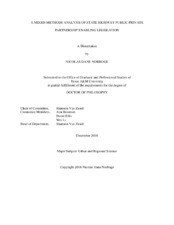| dc.contributor.advisor | Van Zandt, Shannon | |
| dc.creator | Norboge, Nicolas Dane | |
| dc.date.accessioned | 2019-01-23T21:47:03Z | |
| dc.date.available | 2020-12-01T07:31:47Z | |
| dc.date.created | 2018-12 | |
| dc.date.issued | 2018-12-05 | |
| dc.date.submitted | December 2018 | |
| dc.identifier.uri | https://hdl.handle.net/1969.1/174601 | |
| dc.description.abstract | This dissertation features a mixed-methods research design that tests whether outcomes seen so far show a clear public benefit after enacting highway public-private partnership (P3) enabling legislation into law. For this dissertation, public benefit is measured via three sub-hypotheses: reduction in debt (Hv1), increased project innovation (Hv2), and leveraged potential (Hv3). A statistical analysis is used to test Hv1 while hypotheses Hv2 and Hv3 are examined using a qualitative case study design comparing Texas and California.
Results from the quantitative and qualitative portions of this dissertation suggest mixed evidence on whether states with P3 enabling legislation provide increased public benefit. The quantitative portion of this study tests the impact of debt (Hv1) by conducting paired sample t-test of the average annual state obligations for highway projects in states before and after enacting P3 enabling legislation. These results suggest a statistically significant increase in debt obligations after enacting P3 enabling legislation (p < .001). On the contrary, qualitative results support Hv2 and Hv3: a clear majority of interviewees from both Texas and California report that P3 enabling legislation has benefitted the public by increasing project innovation (Hv2) and allowing additional leverage potential (Hv3). Overall, interviewees from Texas and California continue to view P3s as one policy “tool” among a wider set of alternative delivery approaches supporting successful planning and project delivery.
The mixed results of this study point to the need for additional research on P3 enabling legislation. In particular, there is a need to develop validated quantitative measures that assess the before and after effects of P3 enabling legislation. A comprehensive, publicly-available data set of outcomes for transportation infrastructure projects—delivered via the conventional design-bid-build method versus alternative delivery methods— is sorely needed. Further research in P3 enabling legislation will help ensure that academics and planners possess the tools necessary to measure outcomes and ultimately assure they are applied to benefit the public. | en |
| dc.format.mimetype | application/pdf | |
| dc.language.iso | en | |
| dc.subject | public-private partnerships | en |
| dc.subject | transportation | en |
| dc.subject | public policy | en |
| dc.title | A Mixed-Methods Analysis of State Highway Public-Private Partnership Enabling Legislation | en |
| dc.type | Thesis | en |
| thesis.degree.department | Landscape Architecture and Urban Planning | en |
| thesis.degree.discipline | Urban and Regional Science | en |
| thesis.degree.grantor | Texas A & M University | en |
| thesis.degree.name | Doctor of Philosophy | en |
| thesis.degree.level | Doctoral | en |
| dc.contributor.committeeMember | Bowman, Ann | |
| dc.contributor.committeeMember | Ellis, David | |
| dc.contributor.committeeMember | Li, Wei | |
| dc.type.material | text | en |
| dc.date.updated | 2019-01-23T21:47:04Z | |
| local.embargo.terms | 2020-12-01 | |
| local.etdauthor.orcid | 0000-0003-3017-0302 | |


